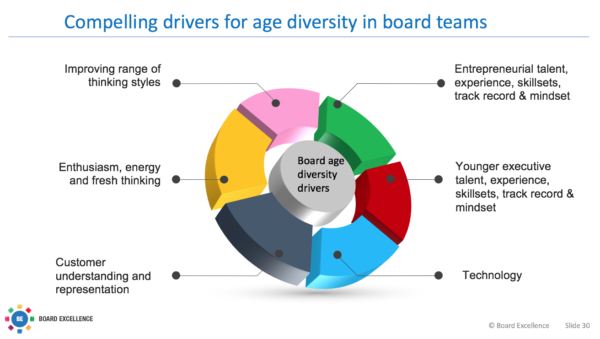In recent years the major focus on board diversity has been correctly on the gender area and I have seen first hand in the board teams that we have supported across Ireland and the UK, the significant improvement that the addition of high-calibre female non-executive directors has made to the board team’s effectiveness, performance and diversity of thinking styles. In recent months, I have noticed an increasing trend from progressive board teams to re-think their approach to age diversity on their boards and utilise the opportunity to bring on younger non-executive directors to the board team. Recent research by the executive search group Spencer Stuart has indicated that the average age of non-executive directors in the top 150 companies in the FTSE rankings topped 60 for the first time this year. This research also indicated that Boards in France, Italy, Netherlands and Norway, in particular, were “seeking the experience of younger directors to tackle emerging issues such as cybersecurity and the rise of disruptive technology”. The age profile in FTSE boards is very much mirrored by the age profile of company board teams, from SME to large private companies.
In reflecting on age diversity on boards, it’s important to appreciate both the traditional model of how non-executive directors were appointed to boards and the radical change that has occurred in recent years in the professional career path. Traditionally, non-executive board members were filled from the ranks of retiring executives usually in their sixties and seventies with a wealth of experience and importantly the time to devote to their board role. Twenty years ago, it would simply have been un-thinkable for a non-executive board director in their thirties or even forties to be appointed to a board. This is now changing as we have very high-calibre entrepreneurs and company executives in their 40s ( and sometimes even younger ), who are making a conscious decision to step back from the executive world, often for family and work-life balance reasons, to take on a number of non-executive board roles. So what are the unique skillsets, enterprise and attributes that these younger non-executive directors bring to a board team ? These are outlined in Figure 1 taken from our board best practices workshop and discussed below ;

Entrepreneurial talent, experience, skillsets, track record and mindset
The vast majority of boards are facing very significant challenges as market sectors are undergoing radical levels of change in terms of new business models, technology disruption, increased levels of competition and macro-economic un-certainty. The addition of a non-executive director who has demonstrated a strong track record of bringing innovation to the marketplace and building successful businesses can bring a whole new dimension to a board team in terms of strategic firepower, looking at the company’s current position in a very new light and could help bring a whole new level of fresh thinking to the board team particularly in the strategy area. A board chair recently commented to me that while they had quite an experienced board team with a lot of industry veterans, a recent new non-exec who was a very successful entrepreneur in an adjacent market, re-energised the board team in the strategy area and while the existing board members didn’t agree with a number of the options the new non-exec put on the table, the net effect was a far richer more open and more ambitious board team that raised its game significantly in the strategy area. While a non-executive role will only suit a certain number of entrepreneurs, where there is a good fit, the addition of a high-quality entrepreneur to a board team with sharp new strategic thinking can be very powerful.
Younger Executive talent, experience, skillsets, track record and mindset
Over recent years, the executive pathway within companies has changed and you are seeing an increasing number of younger executives in their forties with levels of responsibility in terms of P&L, scale of teams and international scope that would have corresponded to executives in their late 50s and 60s not too long ago. These younger executives who decide to step away from the 7×24 executive world and pursue the non-executive director path, bring not only the traditional executive, business and leadership experience to a board team but they also bring a freshness in terms of their experience and attitude. At a time of increasing focus on culture within the board and the broader organisations, I have seen examples of younger non-executive directors bring very different attitudes to areas like employee engagement, customer-centric mindsets, technology adoption and partnering in the marketplace.
Technology
We are now truly in a digital age where technology is pervasive for every organisation and their customers. If you really put it up to the majority of boards with an older age profile, they will honestly admit that the vast majority of their non-execs often struggle with technology both in terms of understanding technology itself but more importantly struggle with how it impacts customers today and how the relentless waves of technology disruption such as artificial intelligence will alter the market landscape. A very good example of this is the case of cyber-security and why so many traditional boards really struggle in this area. Many boards have shied away from really embracing their responsibilities properly in the cyber-security area because the board members are so un-comfortable with technology and despite plenty training being offered, they really struggle to understand the challenging area of cyber-security. Any high-calibre non-exec in their thirties or forties today would be immersed in technology and in many cases would seriously strengthen the non-exec ranks of a board team.
Just Eat, the takeaway delivery operator that has just been promoted to the FTSE 100, is one of the outliers in terms of the average age of a FTSE board with 50 per cent of the board under 50, with an average age of 49.1.While Just Eat is a relatively new technology-centric company, I found the following comment from their interim non-executive chairman Andrew Griffith very prescient when he said: “Just Eat is an example that a younger board with more digital experience can be at least as valuable as age. As a consumer-tech business with a younger customer base, it’s crucial that the board have the skills and even the vocabulary to engage successfully.”Technology is so fundamental now to every organisation and its future that progressive board teams are ensuring that the non-exec ranks are being refreshed with a non-exec director with genuine technology DNA and in most cases that means a younger non-exec director.
Customer understanding and representation
Some years ago, I saw an article highlighting a number of the boards of female cosmetics companies who did not have a single female board member. I thought at the time it was absolutely baffling and I believe today more and more boards are taking a step back to ensure that their non-exec board members are, where possible, genuinely representative of their customer base. Now, more than ever, board teams need to build a deep understanding of their customers, the changing dynamics of the customer environment and ensure that they are matching/exceeding the level of understanding of customers by their competitors. One of the reasons I believe that many traditional giants in some industry sectors lost their way to new entrants is that you had a board with members who were genuinely out of touch with the realities of their customers, their changing needs and in some cases clung on irrationally to business models and product lines that had worked up till then but now didn’t align with customer needs. Bringing a younger non-executive director into a board team with an average age in their late 50s and early 60s will undoubtedly help strengthen the understanding of the board team of their customers and their changing needs in the majority of sectors.
Enthusiasm, energy and fresh thinking
A CEO recently commented to me that he was genuinely taken aback by the positive impact the addition of a 44-year old non-executive director earlier in the year made to their board. The CEO initially thought there would be a novelty impact but three board meetings later, the CEO feels that the new non-exec has brought a whole new level of enthusiasm and energy to the board team that has also lifted the other board members. The CEO was very happy with the calibre and contribution of the existing non-execs but for a long time both the CEO and board chair had struggled with the board becoming extremely predictable and “safe”. There was a genuine welcome for the new non-exec who has really enjoyed what is their first non-exec board role, getting to understand the company, building the relationship with the executive and board team with a strong commitment to delivering value. Many board teams, even those with experienced board members, can plateau and get into a steady groove where while the board is functional, it loses its spark and its level of performance declines. A high-calibre vibrant young non-exec director could represent a catalyst to help spark a board back into life, drive energy levels up and support a high-performing board culture.
Improving range of thinking styles
One of the most important benefits of adding a younger non-executive board director is the increase in the range of thinking styles in the board team. This is critical not only in the strategy area but importantly helping a board team to avoid a serious group-think problem which is more common in boards than what is widely recognized. In my experience, there is quite a difference in thinking style in non-executive board directors who in their late thirties and early forties compared to non-executive board members who are 10 to 20 years older. I find in working with board teams who have genuine age diversity that this difference in age is actually quite a positive and enables a very wide mix of experiences, perspectives, judgement and thinking styles to be harnessed by the board as part of excelling as a highly diverse high-performing board team.
Summary
In supporting board teams week in week out, I have seen both sides of the diversity coin in terms of the traditional board teams with an average age of 59 and those progressive teams who have truly embraced both gender and age diversity. For a board team considering taking on a younger non-executive director, the fundamentals remain the same in terms of taking on any non-exec director i.e. ensuring you have a very high-calibre professional with outstanding levels of ethics, integrity, work ethic and a genuine commitment to being a strong contributor to the board team. Progressive board teams are increasingly seeing the strong benefits of genuine age diversity in the board team and bringing in younger non-executive directors. Some of the very best board teams I have seen in terms of board effectiveness and performance have a real diverse mix of male and female non-executive directors with a spread of age profiles harnessing the outstanding experience and judgement that the veteran non-execs have complimenting the fresh perspectives and technology DNA of younger non-exec directors enabling a vibrant board team with a great range of thinking styles energetically driving forward and supporting a long-term sustainable successful future for their organisation.
Kieran Moynihan is the managing partner of Board Excellence ( https://boardexcellence.com) – supporting boards & directors in Ireland, UK and internationally excel in effectiveness, performance and corporate governance.
Think your business could benefit from our services and expertise? Get in touch today to see how we can support your board excel for its shareholders, employees and stakeholders.

